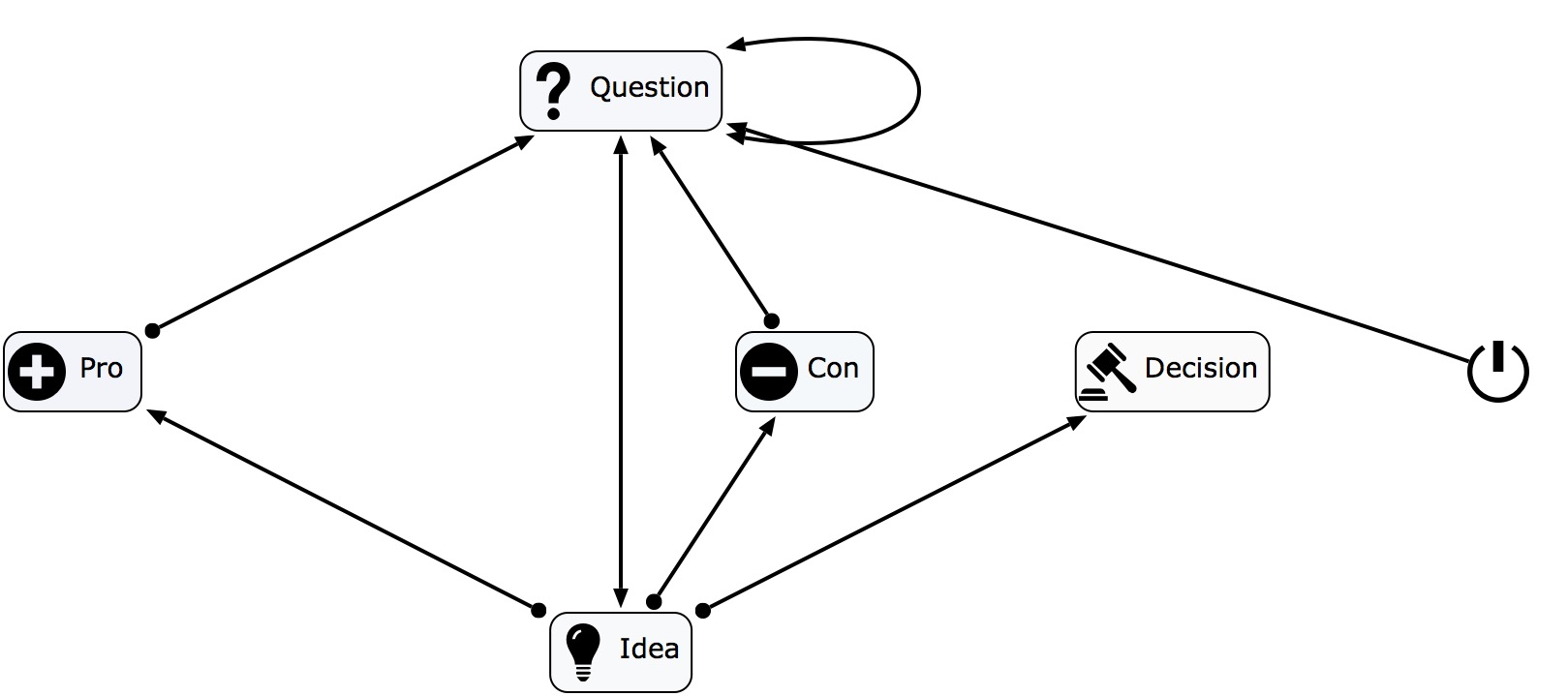The IBIS Notation
Estimated reading time: 3 minutes.
Why use IBIS?
I use the IBIS to describe itself.

Explaining IBIS with IBIS
Issue-based information systems (IBIS) can display any conversation or thought process. The notation itself is straightforward. IBIS diagrams have only four node types: questions (everything can be questioned), answers/ideas as responses to questions and arguments for each of these answers and ideas. Adding questions to every other node allows you to explore each part of the diagram in any depth needed or wanted.
IBIS Notation Definition
The graph below describes the IBIS Notation. The Question Node Type is the starting point (hence the edge from the start symbol). From the question, you can create a successor Idea. Pro and Con Nodes can follow ideas. Questions can be successors to all Node Types.

The IBIS Notation structure
| Node Type | Description | Is Starting Point | Successors |
|---|---|---|---|
| Question | Questions are the key driver of IBIS. They are the starting point and the one item that can be connected to all other nodes. | Yes | Idea, Question |
| Idea | An idea (depending on the context, you can call it as well as an answer) for a question. Ideas are used to answer your questions. | No | Pro, Con, Question |
| Pro | Arguments in favour of an idea. Add anything that you think is relevant to a given idea or answer. The Pros will later help you make a decision. | No | Question |
| Con | Arguments against an idea. Add anything that you think is relevant to a given idea or answer. The Cons will later help you make a decision. | No | Question |
| Decision | When the IBIS map is finalised, you often want to evaluate the map and decide on your next step. Attach this Node Type to an Idea to depict your chosen idea/answer. | No | (None) |
| Best Idea | (not depicted in the diagram above) Instead of using the decision, you can highlight one idea as the "best idea". | No | (same as Idea) |
What is the IBIS Notation?
Werner Kunz and Horst Rittel invented the Issue-Based Information System (IBIS) Notation as an argumentation-based approach to support the analysis of so-called "wicked" problems. However, IBIS Notation can be used for all issues, whether wicked or not.
Use Vithanco to create and change IBIS diagrams to map out a dialogue/argumentation or a thought/analysis. It uses a simple structure to help you get to the bottom of your problems.
The IBIS Notation is a simple graphical presentation of questions and answers with their respective advantages and disadvantages with the following rules:
- A question can have any number of answers or ideas.
- Any answer/idea can have any number of arguments for each answer, split into the two categories of pros and cons.
The result is a simple graphical representation of a question. You can use it for any question and briefly explore a topic. It interests all those who prefer a visual representation instead of a textual description.
The concept of the IBIS notation is deliberately kept simple to make it worthwhile for many use cases. The only so-to-say “complication” is that you can attach a question to any other item. As such, you can:
- question a question (“Shouldn’t we rather discuss X?” or “What are the assumptions behind this question?”), or you can
- question an answer (“To follow this idea, what would we need to take into consideration?”, “What proof do we have for this statement?”), or you can
- question pro or con (“What could we do to overcome this disadvantage?”).
Each question would have its structure with answers/ideas and pros& cons. And, of course, can these have further questions attached? Nothing restricts how big the IBIS diagram might become. You, as the creator, decide how many questions you want to include asks and how “deep” you want to go with your diagram to analyse the topic at hand.
Further Information
- Wikipedia: https://en.wikipedia.org/wiki/Issue-based_information_system
- Working Paper (1970): Issues as Elements of Information Systems by Werner Kunz & Horst Rittel
- Dialogue Mapping by Jeff Conklin